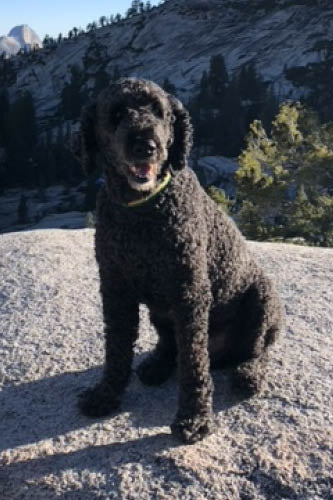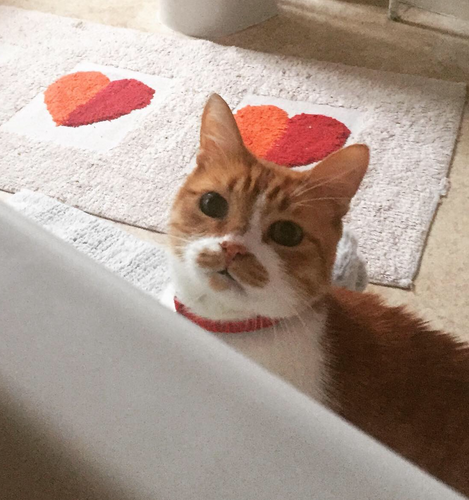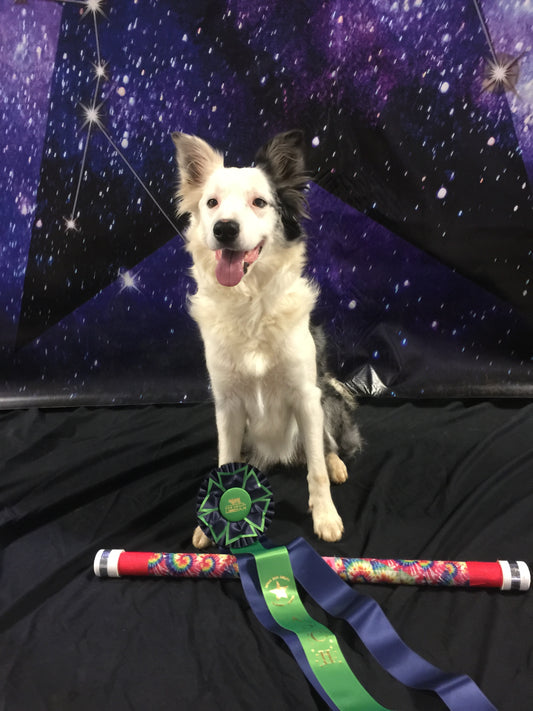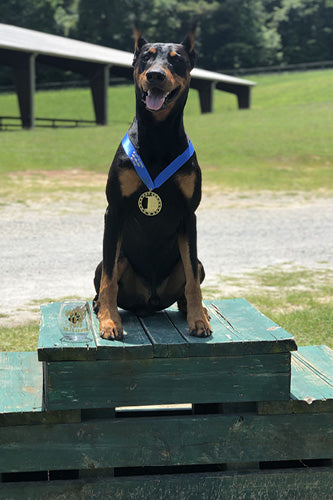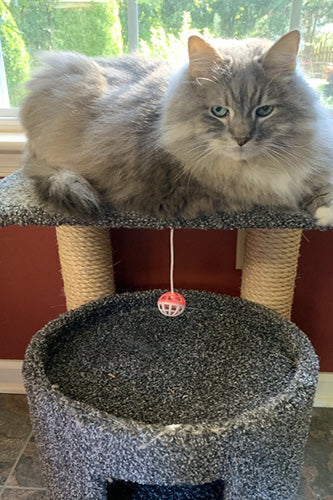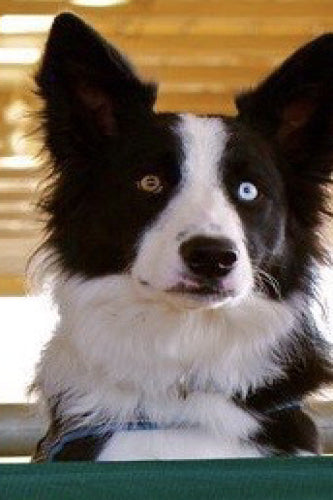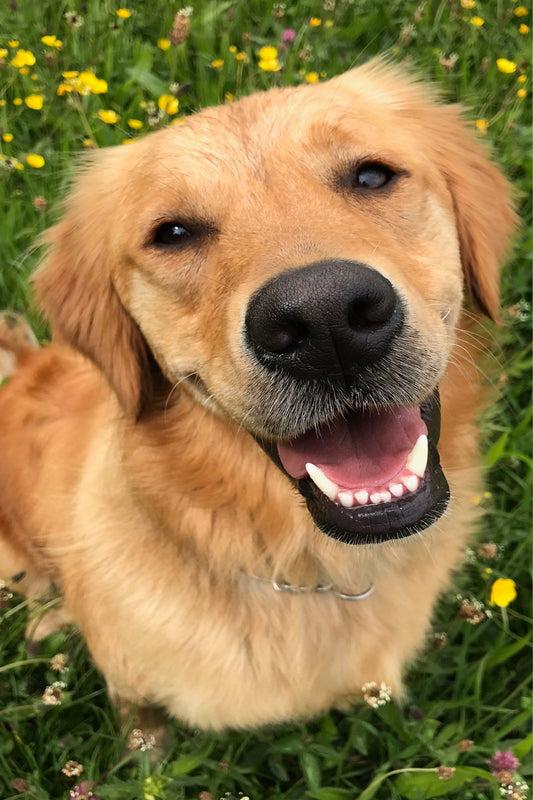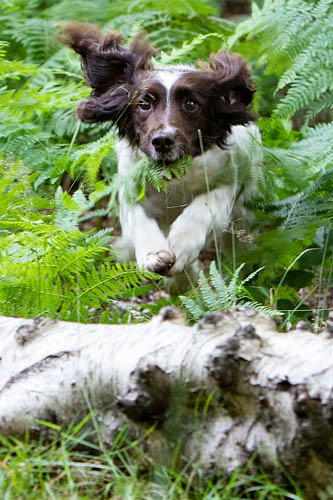But maybe you haven’t started yet, and you’re browsing the internet, looking for a fun activity for you and your dog. So what is dog agility, how do you get started, and how does it benefit your dog?
Well, you’re in the right place. Get pumped for our “agility 101” and hit the ground running.
What is dog agility?
Dog agility is one of the most popular dog sports in the world, with local, national, and international competitions and a huge following of pet owners having fun with their dogs.
 Your dog will run a super-speedy, action-packed zoom around a course of obstacles while you direct them where to go and which obstacle to hit next. It's a test of accuracy, speed, and the relationship between you and your dog.
Your dog will run a super-speedy, action-packed zoom around a course of obstacles while you direct them where to go and which obstacle to hit next. It's a test of accuracy, speed, and the relationship between you and your dog.
You can train your dog in agility for fun, to work on their obedience, fitness, and behavior, or to compete against other dogs. Or all of these. Agility is a super-inclusive, flexible sport for dogs and humans of all ages.
What are the benefits of agility for dogs?
Agility training for dogs is fun and good exercise
Running through a course of jumps and obstacles helps dogs to burn off excess energy and keeps their bodies and brains fit and active. Agility helps to strengthen your dog’s body, build muscle, burn fat, and improve coordination and proprioception.
Plus, it keeps you active too. You don’t have to jump any jumps, but you’ll be zipping around, getting into the right place to direct your dog to the next obstacle. It’s a workout for your brain too!
It feeds their natural instincts
Dogs naturally want to run, pursue their prey, speed through the undergrowth, dodge trees, and jump holes, all to reach their wild dinner. Mostly, we can’t feed this instinct to run, to navigate an intricate landscape at speed. They head to the dog park or get out on the trails, and thats about it.
 Dog agility allows them to practice those inbuilt skills of navigating obstacles, jumping, and running at full speed. Agility courses are built to mimic these natural behaviors and channel them into a safe, competitive environment.
Dog agility allows them to practice those inbuilt skills of navigating obstacles, jumping, and running at full speed. Agility courses are built to mimic these natural behaviors and channel them into a safe, competitive environment.
Agility strengthens the relationship between you and your dog
When running an agility course, your dog relies on you, as their handler, to guide them. To tell them where to go and what to do. It’s a test of your communication skills.
You’ll learn new commands, build on your dog’s obedience and listening skills, and deepen your understanding of dog and human body language.
Once you get started with agility, your canine communication skills will skyrocket, and you’ll have more fun with your dog, strengthening the bond between you.
Dog agility improves behavior
To get your best rounds, you and your dog will work together to build on your dog’s obedience, listening skills, and focus. You’ll need to be their world, their everything, to keep their mind on the round rather than on the distracting environment outside the ring.
Your dog agility club is a fantastic way to socialize your dog with others, as well as to make like-minded friends of your own.
A fit, healthy dog whose mind and body are actively challenged tends to be a well-behaved, calmer dog in the long run.
What obstacles will you meet in a dog agility trial?
When it comes to equipment, dog agility has a lot going on. But dont worry. You don’t need to own jumps or build an A-frame in your backyard. You can if you want to, and many owners do (check out our article on building your own agility obstacles), but most local clubs have everything you need.
- Jumps - Jumps vary in height and width, depending on the competition, experience of the dogs, and the dog’s size. There are usually around 15 jumps in a standard course, including hoops, walls, broad jumps, and tire jumps. Faults are earned for knocking a pole down; you can be eliminated for missing a jump or jumping the wrong way.
- A-frame - The A-frame is a tall obstacle that dogs climb up and over. They must touch the “contact area” on the way up and down. Testing their strength, control, and accuracy.
- Dog walk - This is the biggest piece of agility equipment on the field. The dog walk tests your dog's control and accuracy. It consists of a raised balance beam with a slope up and down. As with the A-frame, the dogs must touch the contact areas on the way up and down.
- Pause table - This might be an actual, non-slip table that dogs have to jump onto, or a box marked on the floor. It is often around the middle of a course or after a fast run. Dogs must stop within the box or on the table for a set amount of time, usually around 5 seconds, before they are given the next command.
- Tunnels - a favorite of many agility dogs, the tunnel can be straight or curved. Some tunnels are collapsed at one end so that dogs push through the fabric. These are more old-fashioned, seen less often than a full tunnel, and rarely in competitive agility.
- See-saw or teeter-totter - A tricky one to teach your dog, but something they will learn quite often. Dogs must run up one side of the see-saw and pause until the other end touches the ground. They must touch both contact areas at each end before jumping off.
- Weave-poles - Probably the most challenging obstacle on the course. Tricky to train, tricky to get right, and mentally and physically challenging for your dog. Dogs must enter the weave poles with the first pole on their left shoulder, then zig-zag through the poles as fast and as accurately as possible.

Is dog agility safe for my dog?
The key to enjoying dog agility is making it as relaxed and fun as possible for you and your dog.
Generally speaking, agility is a very safe sport for your dog, as long as you train in a controlled environment, under expert guidance, until you are experienced enough to know what you are doing.
Agility is incredibly good for your dog’s mental stimulation and physical well-being. It helps to keep them super fit, lean and strong. The concentration, learning, and focus required from them keeps their mind active and healthy, which benefits their long-term health and mental wellbeing.
Agility is a high-impact dog sport with lots of jumps, twists, and turns. Course builders are now very aware of the impact of their courses on the dog’s bodies and are building courses with that in mind—to protect and mitigate against injuries. But as with any high-impact sport (even in humans), the risk of injury is higher than in low-impact activities.
The jumps, twists, and turns put greater strain on your dog’s joints and muscles.
Those competing at high levels work hard to support their competing dog’s joint health and mobility, with the support of various professionals, such as nutritionists, physiotherapists, and veterinarians.
But even if you’re heading to an agility club for fun, you can do plenty of things to help keep your dog safe.
- Complete a proper warm-up and cool-down
- Train the basics properly before moving on to more technical or faster work
- Maintain your dog at a healthy weight—excess weight adds to joint stress
- Keep nails trimmed to help prevent slips
- Don’t train too much and increase training gradually
- Consider a dog joint supplement to support joint health.
Read how world-renowned agility trainers Dave Mannings and Dan Shaw support their dog’s joint mobility.
Who can do dog agility?
Dog agility is a very inclusive canine sport, open to everyone. Dogs of all ages, breeds, shapes, and sizes can get involved and enjoy the fun and exhilaration of running around a couple of agility obstacles.
In agility competitions, dogs are split into jump height categories and often into ages and experience levels—moving up the grades as they progress.
What age can my dog start agility?
Dogs can start agility classes that includes jumping, from 1 year old. It may be a little later if you have a particularly large breed dog. However, many agility training groups run puppy classes that don’t include jumps or high-impact equipment. They are a great way to get your puppy started and begin to build the grounding for their future agility career in a safe manner.
If you are worried about the impact of jumping on your dog’s joints, you could consider finding a local Hoopers group. All the fun of agility, without the impact on joints.
Which breeds of dog are best at agility?
Any breed of dog can enjoy agility, including mixed breeds. All dogs can get involved, no matter their size or shape—but some breeds are well known to be agility superheroes. For example, the Border Collie is a regular on the agility podiums worldwide due to their speed, agility, and trainability.
Find out which are the top ten dog agility breeds.
How do I start canine agility?
The best way to get started in dog agility is to join a local training class. You can find groups all over the United States who train for fun or competitively. Start by speaking to local dog trainers or searching national agility organizations such as the USDAA, NADAC, or the AKC.
Start by ensuring your basic obedience commands and training are solid before moving on to more technical dog agility commands and cues.
Now you know what dog agility is all about, it’s time to get out there and have some fun! We would love to see some pictures or videos of your speedy pooches enjoying their rounds. Get in touch here.
If you’re looking to support your canine athlete's joint health, Antinol is the Joint health supplement of choice for the USDAA—see how Antinol supports agility dogs in the US.



